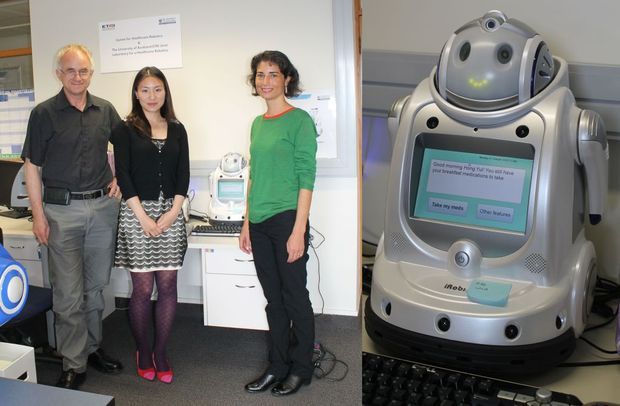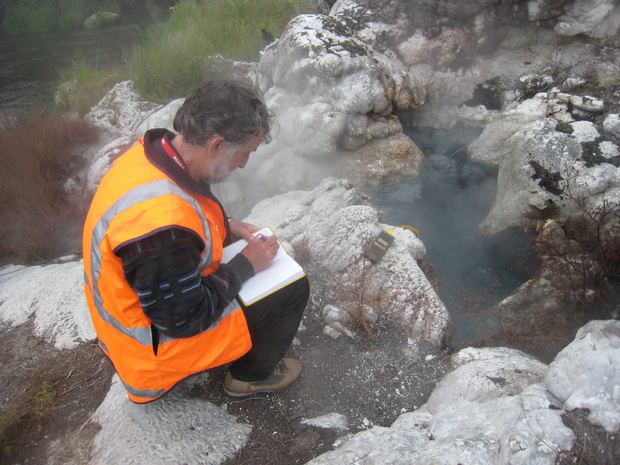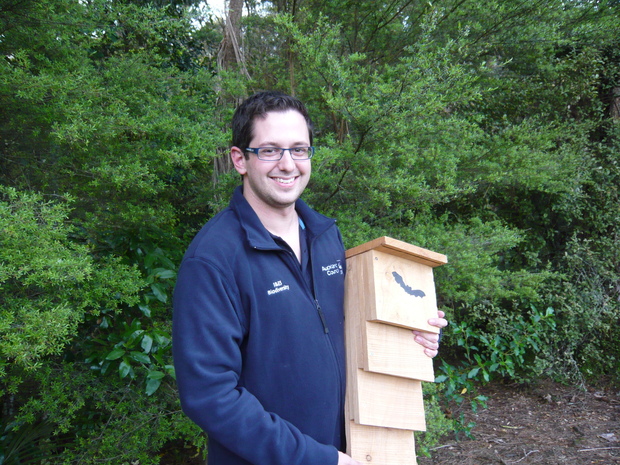Our Changing World for Thursday 7 November 2013
Papakura Geyser
GNS Science volcanologist Brad Scott taking a temperature reading at the Papakura Geyser (images: Lisa Thompson).
The Papakura Geyser at Whakarewarewa (Te Puia) was once known for its spectacular and continuous hot water eruptions which reached heights of two to three metres. However, its failure in 1979 led scientists to advocate for the closure of many bores in the area because they were detracting from Rotorua's natural thermal attractions.
They achieved the closure of about 300 bores within a 1.5 km radius of Whakarewarewa, despite strong resistance from some bore owners. The Regional Council then implemented the Rotorua Geothermal Management Plan to manage the future recovery of the Rotorua system.
During a recent monitoring visit, scientists were excited to discover that Papakura had erupted and was overflowing at 97 degrees Celsius. Scientists have also noticed an increase in geothermal water coming into the ‘throat’ of the iconic Waikite geyser.
GNS Science volcanologist Brad Scott says witnessing signs of recovery at the Papakura Geyser is a career highlight and proof the bore closure programme was necessary to rejuvenate geothermal activity in the area.
Electric Car

From left to right: the electric car, the steering wheel, and Tom Qi (image: Isabella Harrex, Otago Polytechnic)
Tom Qi from Otago Polytechnic has developed an electric car with four separately powered wheels, enabling each wheel to steer independently. Unlike conventional cars, the four wheels are not mechanically linked. The prototype can drive sideways, for easy parallel parking, and spins 180 degrees to make a U-turn.
The car has in-wheel motors and all-wheel steering, which means that a steering wheel is not necessary. At present, the steering wheel has computer like buttons which can be used to control the wheels, but in the future the car may be controlled with a joy stick. When driving in a straight line, or taking smaller corners, the steering wheel is used to control the vehicle. Ruth Beran went to Dunedin to see the car, but also discovers the limitations of running a car on batteries.
The car is a collaboration between Otago Polytechnic, the National Taiwan University of Science and Technology and Shenzhen Polytechnic.
You can see the car here, driving forward, driving backward, driving sideways to the right, driving sideways to the left, and doing a U-turn.
The Changing Face of Robots

Bruce MacDonald, Healthbots project leader Jiao Xie and Elizabeth Broadbent, with iRobi, a robot especially designed for medical assistance in rest homes, private homes and health centres (images: Lisa Thompson).
A recent University of Auckland study has revealed a preference for humanlike features on a robot’s display screen. The study was a collaboration between researchers in health, psychology and robotics from The University of Auckland, and aimed to understand the impact of robots with screens.
Study leader Elizabeth Broadbent, says the study tested how appearance affected people’s perceptions of the robot’s personality and mind. The majority of participants (60 per cent) preferred the robot displaying the most humanlike skin-coloured 3D virtual face over a robot with no face display (30 per cent) and a robot with silver-coloured simplified human features (10 per cent).
Study participants interacted with each of the three types of robots in a random order while it helped them use a blood-pressure cuff and measured their blood pressure. Participants then rated the robots’ mind, personality and eeriness each time. The robot with the most humanlike on-screen face display was most preferred and rated as having the most mind, being most humanlike, alive, sociable and amiable. The one with the silver face display was rated by participants as the most eerie, moderate in mind, human-likeness and amiability.
Study collaborator Bruce MacDonald says the research will help guide future development of ‘socially assistive’ robots that are being designed for healthcare. The research was published in the online scientific journal Plos One.
Auckland's Urban Bats
Auckland Council biodiversity advisor Ben Paris, aka NZ Batman, with one of the bat boxes the council has installed in Swanson Reserve in the hope that they will encourage long-tailed bats to start roosting there. (image: V Meduna)
Few people will have seen New Zealand’s thumb-sized native bats, the country’s only native land mammals. In pre-human times, they darted about the forests in their millions, but today they are reduced to a few scattered groups.
There were once three species but the greater short-tailed bat was last seen in the 1960s and is now thought to be extinct. Of the two other species of bat, long-tailed bats, Chalinolobus tuberculatus, are more common than lesser short-tailed bats, Mystacina tuberculata, but they are seldom seen as they emerge from their roosts around dusk to hunt. They feed exclusively on flying insects, form complex social groups and, as research on radio-tagged bats in Fiordland's Eglinton Valley has shown, frequently switch between roosting alone and roosting with a colony.
Worldwide, there are two types of bat: megabats such as fruitbats, which navigate mainly by sight, and microbats, which locate prey using echolocation. New Zealand's bats are microbats. They emit pulses of high-frequency sound and listen for the returning echoes that bounce off objects.
Both lesser short-tailed and long-tailed bats are threatened and in danger of extinction, but long-tailed bats have been found roosting in suburban areas of Auckland. They have been observed feeding at Swanson Reserve, are roosting in the Waitakere Ranges, and the search will be on this summer at Riverhead to find the roosting site of a newly found population.
In this interview, Auckland Council biodiversity advisor Ben Paris (pictured above), perhaps better known as New Zealand Batman, takes Veronika Meduna on a bat-monitoring night walk to explain how people can help the council to detect bats and attract them to their local neighbourhood.
Contact the biodiversity team at Auckland Council on 09 301 0101 or email biodiversity@auckland council.govt.nz for information or to report bat sightings.

